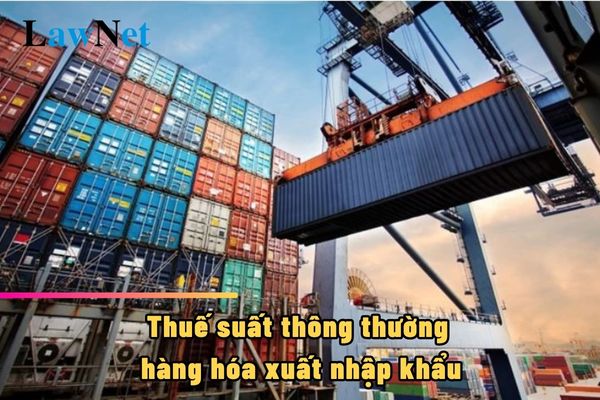What is the ordinary import and export duty rates in Vietnam?
What is the ordinary import and export duty rates in Vietnam?
Based on point c, clause 3, Article 5 of the Law on Export and Import Duties 2016, the regulation is as follows:
Basis for calculating export and import duties for goods applying the percentage tax calculation method
1. The amount of export and import duties is determined based on the taxable value and the percentage duty rate (%) of each item at the time of taxation.
2. Export duty rates are specifically regulated for each item in the export tariff schedule.
In case goods are exported to countries, groups of countries, or territories that have preferential export tax agreements in commercial relations with Vietnam, these agreements shall apply.
3. Import duty rates include preferential rates, special preferential rates, and ordinary rates and are applied as follows:
a) The preferential rate applies to imports originating from countries, groups of countries, or territories granting most-favored-nation treatment in commercial relations with Vietnam; goods from non-tariff zones imported into the domestic market meeting the origin criteria from countries, groups of countries, or territories granting most-favored-nation treatment in commercial relations with Vietnam;
b) The special preferential rate applies to imports originating from countries, groups of countries, or territories having special preferential import tax agreements in commercial relations with Vietnam; goods from non-tariff zones imported into the domestic market meeting the origin criteria from countries, groups of countries, or territories having special preferential import tax agreements in commercial relations with Vietnam;
c) The ordinary rate applies to imports not falling under the cases specified in points a and b of this clause. The ordinary rate is set at 150% of the preferential rate for each corresponding item. In cases where the preferential rate is 0%, the Prime Minister of the Government of Vietnam, based on the provisions of Article 10 of this Law, decides on the application of the ordinary rate.
Thus, according to the regulations, the ordinary duty rate for imports and exports is one of the forms for calculating the duty rate for imports and exports.

What is the ordinary import and export duty rates in Vietnam? (Image from the Internet)
When is the customs declarant required to submit the certificate of origin for goods in Vietnam?
Based on the provisions of clause 1, Article 12 of Circular 33/2023/TT-BTC, for imports enjoying special preferential duty rates, the customs declarant must submit the certificate of origin at the time of customs procedure.
Additionally, in the case where there is no certificate of origin at the time of customs clearance:
- imports must apply the preferential import duty rate or the ordinary duty rate and be cleared according to regulations.
In case there is a credit institution guaranteeing the tax difference amount, the special preferential duty rate will be applied, and goods will be cleared according to regulations;
- The customs declarant declares and submits additional certificates of origin within one (01) year from the date of customs declaration registration.
For imports with certificates of origin applying the Vietnam - European Union Free Trade Agreement, Vietnam - United Kingdom and Northern Ireland Free Trade Agreement, the customs declarant submits additional certificates of origin within two (02) years from the date of customs declaration registration;
- When submitting additional certificates of origin within the above time limit, imports will be subject to the special preferential duty rate, and the customs authorities will handle the overpaid tax amount according to regulations in case the paid tax amount is greater than the payable tax amount;
In case there is a credit institution guaranteeing the tax difference amount between the special preferential rate and the preferential import rate or the ordinary rate, the customs authorities update the processing results on the system and notify the credit institution.
When are certificates of origin for imports and exports accepted by the customs authorities?
Based on clause 7, Article 15 of Circular 33/2023/TT-BTC, the regulation is as follows:
Inspection of certificates of origin for imports
...
7. The customs authorities accept certificates of origin for applying special preferential duty rates in cases where the commercial invoice is issued by a third party. The customs authorities inspect and compare information on the name, country, groups of countries, or territories of the third-party invoice issuer on the certificates of origin and the commercial invoice to determine the conformity and validity according to the relevant Free Trade Agreement that Vietnam is a member of.
...
Thus, according to the above regulation, certificates of origin for imports and exports are accepted by the customs authorities when the commercial invoice is issued by a third party.

